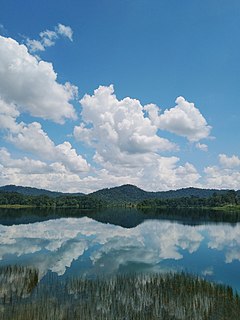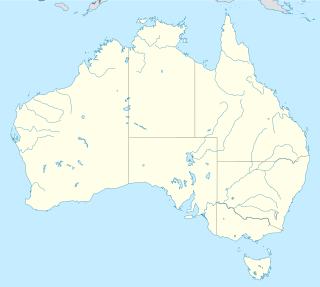Related Research Articles

Ore is natural rock or sediment that contains one or more valuable minerals, typically containing metals, that can be mined, treated and sold at a profit. Ore is extracted from the earth through mining and treated or refined, often via smelting, to extract the valuable metals or minerals. The grade of ore refers to the concentration of the desired material it contains. The value of the metals or minerals a rock contains must be weighed against the cost of extraction to determine whether it is of sufficiently high grade to be worth mining, and is therefore considered an ore.

Iron ores are rocks and minerals from which metallic iron can be economically extracted. The ores are usually rich in iron oxides and vary in color from dark grey, bright yellow, or deep purple to rusty red. The iron is usually found in the form of magnetite (Fe
3O
4, 72.4% Fe), hematite (Fe
2O
3, 69.9% Fe), goethite (FeO(OH), 62.9% Fe), limonite (FeO(OH)·n(H2O), 55% Fe) or siderite (FeCO3, 48.2% Fe).

Bukit Besi is a small mining town in Dungun, Terengganu, Malaysia, famous for its high quality iron ore.

Mining in Iran is still under development, yet the country is one of the most important mineral producers in the world, ranked among 15 major mineral-rich countries, holding some 68 types of minerals, 37 billion tonnes of proven reserves and more than 57 billion tonnes of potential reserves worth $770 billion in 2014. Mineral production contributes only 0.6 per cent to the country's GDP. Add other mining-related industries and this figure increases to just four per cent (2005). Many factors have contributed to this, namely lack of suitable infrastructure, legal barriers, exploration difficulties, and government control.

Mining in the United Kingdom produces a wide variety of fossil fuels, metals, and industrial minerals due to its complex geology. In 2013, there were over 2,000 active mines, quarries, and offshore drilling sites on the continental land mass of the United Kingdom producing £34bn of minerals and employing 36,000 people.
Mining is an important industry in Pakistan. Pakistan has deposits of several minerals including coal, copper, gold, chromite, mineral salt, bauxite and several other minerals. There are also a variety of precious and semi-precious minerals that are also mined. These include peridot, aquamarine, topaz, ruby, emerald, rare-earth minerals bastnaesite and xenotime, sphene, tourmaline, and many varieties and types of quartz .
The Muncelu Mic mine was a large open pit mine in the western of Romania in Hunedoara County, 16 km southeast of Simeria and 387 km north-west of the capital, Bucharest. Muncelu Mic represents one of the largest iron ore reserves in Romania having estimated reserves of 6.5 million tonnes of ore. When it was operational it produced around 200,000 tonnes of iron ore/year. The mine also has a gold and silver reserves of around 5.4 million tonnes grading 1g/t gold and 8g/t silver resulting 173,000 oz of gold and 1.38 million oz of silver.
The Ocna de Fier mine is a large open pit mine in the western of Romania in Caraş-Severin County, 25 km west of Reşiţa and 511 km north-west of the capital, Bucharest. Ocna de Fier represents the largest iron ore reserves in Romania having estimated reserves of 200 million tonnes of ore grading 25% iron metal. The mine produces around 10,000 tonnes of iron ore/year.

The Channar mine is an iron ore mine located in the Pilbara region of Western Australia, 17 kilometres south-east of Paraburdoo.

The Eastern Range mine is an iron ore mine in the Pilbara region of Western Australia, 10 kilometres south-east of Paraburdoo.
Mining in North Korea is important to the country's economy. North Korea is naturally abundant in metals such as magnesite, zinc, tungsten, and iron; with magnesite resources of 6 billion tonnes, particularly in the Hamgyeong-do and Jagang-do provinces. However, often these cannot be mined due to the acute shortage of electricity in the country, as well as the lack of proper tools to mine these materials and an antiquated industrial base. Coal, iron ore, limestone, and magnesite deposits are larger than other mineral commodities. Mining joint ventures with other countries include China, Canada, Egypt, and South Korea.
The Bong mine is a large iron mine located in central Liberia in Bong County. Bong represents one of the largest iron ore reserves in Liberia and in the world having estimated reserves of 4 billion tonnes of ore grading 36% iron metal.
The Benxi mine is a large iron mine located in north-eastern China in the Liaoning. Benxi represents one of the largest iron ore reserves in China and in the world having estimated reserves of 3 billion tonnes of ore grading 43.5% iron metal.
The Cacova Ierii mine is a large open pit mine in the north-western of Romania in Cluj County. Cacova Ierii represents one of the largest iron ore reserves in Romania having estimated reserves of 16.6 million tonnes of ore grading 42% iron metal. The mine has the capability to produce around 415,000 tonnes of iron ore/year.
The Rudăria-Bănia mine is a large open pit mine in the south-western Romania in Caraș-Severin County. Rudăria-Bănia represents one of the largest iron ore reserves in Romania having estimated reserves of 70 million tonnes of ore grading 45% iron metal and 20% manganese metal. The mine has the capability to produce around 500,000 tonnes of iron ore/year.
The Shuichang mine is a large iron mine located in northern China in the Inner Mongolia. Shuichang represents one of the largest iron ore reserves in China and in the world having estimated reserves of 100 million tonnes of ore grading 35% iron metal.
The Baoguosi mine is a large iron mine located in northern China in the Inner Mongolia. Baoguosi represents one of the largest iron ore reserves in China and in the world having estimated reserves of 107.9 million tonnes of ore grading 33.7% iron metal.
The Gongchangling mine is a large iron mine located in northern China in the Inner Mongolia. Gongchangling represents one of the largest iron ore reserves in China and in the world having estimated reserves of 760 million tonnes of ore grading 32.8% iron metal.
The Baizhiyan mine is a large iron mine located in northern China in the Inner Mongolia. Baizhiyan represents one of the largest iron ore reserves in China and in the world having estimated reserves of 179.7 million tonnes of ore grading 33.3% iron metal.
The Jinling mine is a large iron mine located in northern China. Jinling represents one of the largest iron ore reserves in China and in the world having estimated reserves of 166.1 million tonnes of ore grading 51% iron metal.
References
- ↑ "Mineral deposits of Northern Asia". docstoc.com. 2012. Archived from the original on September 23, 2013. Retrieved 2013-07-10.